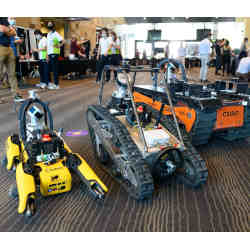
After three long years, the Defense Advanced Research Project Agency (DARPA) Subterranean (SubT) Robot Challenge recently awarded at total of $5 million in prizes to the top three robot team competitors, and a dozen virtual competitors.
DARPA director Stefanie Tompkins compared the SubT Robot Challenge to previous DARPA Challenges in arenas as diverse as autonomous vehicles, global positioning systems (GPS), and the Internet. "This is how DARPA works—our Challenges are just the start," said Tompkins. "Now we at DARPA are working toward using the subterranean robotic technologies created for the Challenge to increase the security of our warfighters, and the civilian sector is developing subterranean robot technologies to increase the security of first responders to natural disasters,"
The purpose of the competition, according to DARPA's Challenge statement, was to seek out "novel approaches to rapidly map, navigate, and search underground environments during time-sensitive combat operations and disaster-response scenarios,"
DARPA Program Manager Tim Chung said the SubT Challenge has yielded improved robotic mapping skills, improved robotic navigation on uneven surfaces, and improved real-time robotic search and execute capabilities, all of which will be tapped in support of U.S. military and first-responder subterranean search and rescue capabilities. Robot makers, military contractors and civilian corporations all can make use of the intellectual property (IP) generated from the SubT Challenge, which is freely available at OpenRobotics.
"From here, there is no limit to where these subterranean robotic technologies can go," said Chung.
New York City Rescue Battalion Commander Joseph Downey explained how the results of the SubT Challenge will be used by his firefighter colleagues. "In New York City, we deal with a tremendous number of underground environments—over 200 miles in length—so having this technology to help us see what is underground can only benefit us. We hope to use this technology to help us to access underground environments during subterranean disasters or even terrorist events," said Downey. "Today we use [oxygen] masks to send people in and report back about subterranean conditions, but the masks only last for a few hours. Robots could greatly improve things by spending as much time as is needed to assess where it is safe and where it is not safe to send in first responders, which could be life-saving."
The Challenge
Competitors in the SubT Challenge were winnowed down over three years of preliminary contests, to eight real-world robot-team finalists. The top three winners together were awarded $3.5 million, while 12 virtual robot-team finalists (using software bots on a video-game-like duplicate of the real-world course) received a combined $1.5 million in prize money.
The teams in the Challenge by navigating subterranean environments while simultaneously mapping them (without the use of GPS) and pinpointing artifacts along the way such as survivor mannequins, backpacks, fire extinguishers, and other equipment and substitutes for victims.
The simulation of the real-world course on which the virtual entries competed was so accurate that the same open-source performance algorithms were run on both the real-world robots and the virtual-world robots, according to Chung.
The SubT Challenge targeted three specific underground environments: Tunnels (as in mining), Urban (as in underground sewers and military bunkers), and Cave (naturally formed). Each were first marked out in the real world, then simulated in software for the virtual robots. For the final contest, all three environments were marked out in the Louisville Mega Cavern created by 20th century limestone mining, then simulated with open source virtual-world software.
Ground Testing
In the preliminary stages of the SubT Challenge held between 2018 and 2020, entries were tested in separate Tunnel, Urban, and Cave contests. For the finals, all three types of underground environments were included in one mega-course. The enormous scale and scope of the final course also included new hurdles to overcome, including fog, muddy train rails, rock falls, uneven ground, mining equipment obstacles, blocked doors to rooms in urban environments, stairs, and human artifact equipment, all of which made it very difficult to navigate, especially for wheeled robots.
Said Angela Maio, virtual competition lead for DARPA's SubT Challenge, "Together these hurdles required teams to make cooperative use of [aerial] drones, legged and crawling robots, along with wheeled robots, to complete all their tasks," said Maio.
The novel solutions to which each team had to resort—plus the unsolved problems no team could overcome—represent a "gold mine" of intellectual property from which military and commercial robot builders can learn, according to Chung. "We are going to learn from the final contest data for years, as we realize the mistakes made and the development we need to do to capitalize on what we have learned."
Real-World Winning Teams
1st Place
Team Cerberus. Prize money: $2 million
The Cerberus team was a cooperative effort of the University of Nevada Reno, ETH Zurich, Sierra Nevada Corporation, University of California Berkeley, drone manufacturer Flyability, the Norwegian University of Science and Technology (NTNU), and the University of Oxford. The team relied mainly on four "ANYmal C" legged robots, plus drones.
2nd Place
CSIRO Data61 Lab. Prize money: $1 million
The Data61 laboratory of Australia's Commonwealth Scientific & Industrial Research Organization (CSIRO) worked with aerial drone manufacturer Emesent and the Georgia Institute of Technology (Atlanta). The team depended primarily on legged robots and flying drones and produced the most accurate map, but was edged out of first place by virtue of taking slightly more total time to find all the artifacts.
3rd Place
MARBLE. Prize money: $500,000
Multi-agent Autonomy with Radar-Based Localization for Exploration (MARBLE) was a collaboration of the University of Colorado Boulder, University of Colorado Denver, Scientific Systems Company, Inc., and the University of California Santa Cruz. The team's robot complement included three Clearpath Husky wheeled robots, one Bulldog tracked robot, three treaded Tank robots, and two Lumenier aerial drones.
Virtual Winners
1st Place
Dynamo. Prize money: $750,000
This team, headed up by Hilario Tomé (chief technical officer and co-founder of Keybotic, which makes autonomous four-legged robots), used virtual quad-copters studded with the lowest-cost sensors available, which shifted the complexity of the problem to software using sensor fusion, optimization, and machine learning.
2nd Place
CTU-CRAS-NORLAB. Prize money: $500,000
Czech Technological University, Czech Republic Université, and the Northern Robotics Laboratory in Laval, Canada, fielded a multidisciplinary team using tracked, wheeled, crawling, and aerial virtual robots.
3rd Place
Coordinated Robotics. Prize money: $250,000
This team included members from the California State University Channel Islands, Sequoia Middle School, Oke Onwuka, and virtual-world competition lead Kevin Knoedler (a previous winner of NASA's Space Robotics Challenge) The team used ground-based robots to deploy relay stations for communications, and aerial drones for artifact identification and mapping.
R. Colin Johnson is a Kyoto Prize Fellow who has worked as a technology journalist for two decades.




Join the Discussion (0)
Become a Member or Sign In to Post a Comment